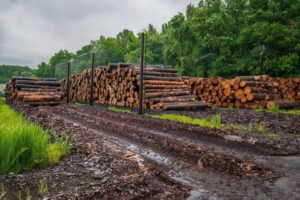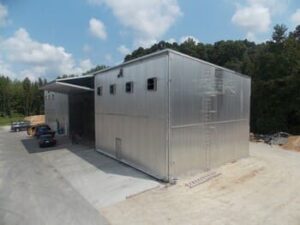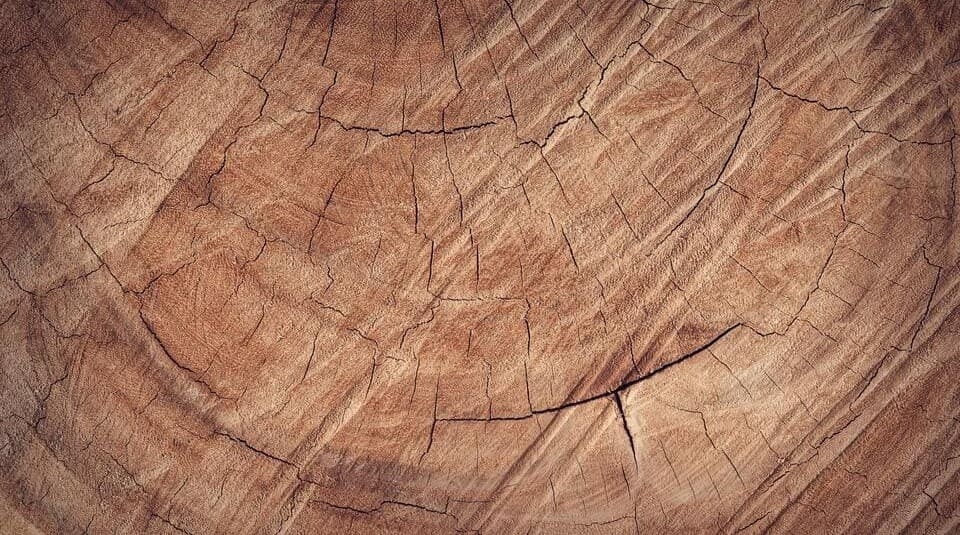We use wood to make furniture, and home decor, throw it in our fireplaces, or carve it to design some amazing wood sculptures. You will eventually find out the wood you typically need for many of these activities requires properly kiln-dried wood. You may be wondering why you need kiln-dried wood? What’s wrong with rough-sawn lumber? How long does it take to kiln-dry wood? We will answer these questions below.
Rough sawn lumber holds a lot of moisture from the original tree it was cut from. This lumber that isn’t dried will naturally dry over time and shrink as the moisture leaves the wood. Mix in different humidity levels in homes and you’ll find that rough-cut lumber may not accomplish what dried lumber can. Having furniture, home decorations, or sculptures warp and shrink doesn’t sound like a great way to serve customers, does it?
There are several processes to remove moisture from the wood but it ends up being a long process from falling a tree to holding usable dried wood in your hands. The traditional way of doing this is air-drying lumber.
Air-drying is a completely manual process wherein you need to chop the wood into smaller pieces and stack them up with enough space between them so that the air can do its job. This process lacks consistency as how well and how soon your wood will dry depends on the humidity in the atmosphere and the environmental temperature.
It also takes a long time to dry the wood. The average time to air-dry most kinds of wood is about a year per inch. This means that if you want your wood to shrink by 2 inches before you can use it, you have to let it dry for two whole years!
Thankfully, there is a quicker way to dry wood and that is kiln-drying. So, how long does it take to kiln-dry lumber? We’ll take a look at it shortly. First, let us understand the process of kiln drying and talk about its benefits.
Table of Contents
How Long Does It Take to Kiln-Dry Wood?
Well, it depends on the species of wood. A 2-inch thick walnut takes about 3 weeks to completely dry while pine and poplar wood takes about a couple of weeks. Red oak is a bit tricky so it could take about four to six weeks. Kiln-drying white oak can take about a month. Maple wood takes a bit longer but still, the feat can be achieved in about two months when you use a kiln instead of air drying. So how long does it take to kiln-dry wood? Here’s our basic wood kiln drying time chart. In general, expect to Kiln-Dry your lumber for 6-8 weeks. If you have a few weeks of air-drying the dry time can be shorter depending on the species of wood.
Walnut Kiln Dries in about 3-4 Weeks
Pine Kiln-Dries in about 2-3 Weeks
Poplar Kiln-Dries in about 2-3 Weeks
Red Oak Kiln-Dries in about 4-6 Weeks
White Oak Kiln-Dries in about 4-5 Weeks
Maple Kiln-Dries in about 8-9 Weeks
If your wood is already air-dried to an extent, then kiln-drying can take even lesser time. For instance, kiln-drying air-dried white oak may take just a couple of weeks. Be it any type of wood, the drying time can be drastically reduced from years through air-drying to weeks/months using a kiln.

What Is Kiln-Drying?
As the name suggests, kiln-drying is a process where the wood is dried in a kiln. A kiln consists of a chamber where the flow of air, moisture, and temperature can be controlled. This method ensures that wood can be dried to the desired moisture level without causing it to over-dry.
And because it is a controlled process, you can also greatly speed up the process of removing moisture from the wood when compared to the traditional air-drying method. You’d be scared to know how long it takes to kiln-dry wood through an air-dried method if you need the lumber this year.
How Does Kiln-Drying Work?
When wood is gathered after felling trees, it usually goes through the process of debarking. And then the wood pieces are sorted according to their types and sizes, keeping the final use into consideration.
Once they are evenly chopped and trimmed to the desired length, they are placed into the chamber of the kiln. The heated air and the pressure in the chamber enable the moisture from the wood to quickly rise to the surface of the kiln. This process ensures that the wood not only dries quickly but also retains much less moisture than traditional methods of drying.
The time taken by the kiln to dry wood depends on the type of wood and some types of wood may require slow drying. Drying certain types of wood too quickly can cause cracks to appear in the wood, rendering it unusable. These cracks are also called checks.
The right way to avoid these checks is to start drying woods slowly in the beginning and then increase the speed when the moisture content in the wood reduces to about 25%. You can use moisture meters to measure the moisture content of the woods throughout the drying process.
So, how does the wood dry in the kiln? There are three stages.

Stage One
The first stage is when the lumber is completely wet. Before this stage, the moisture in the outer and the inner portions of the wood is evenly distributed. As drying begins, the moisture in the outer portion reduces more quickly than in the inner portion.
The point at which the outer portion reaches the fiber saturation point is measured by its moisture content, which is typically 28 to 30 percent. Eventually, the inner portion of the lumber reaches the fiber saturation point in stage 1 as well.
Stage Two
As you continue to subject the kiln to heat, it may seem like the outer surface is drying too much but the inner portion of the wood is moist. Our top-quality lumber kilns can help prevent this. The inner portion being too moist could be a problem, but because the interior portion of the wood maintains its moisture at a certain level, it prevents the outer surface of the wood from cracking or shrinking too much.
However, if the temperature is too high, the surface may crack and cause a surface check. To prevent this, you can increase the humidity level in the kiln and/or reduce the temperature.
Stage Three
In stage three, the central portion of the lumber begins to lose its moisture and tends to shrink. But the outer fiber of the wood now contains a different tensile strength than what it had when the drying process was initialized. And this tensile strength prevents the inner center from shrinking.
However, if stage three goes on for too long, then it could cause a phenomenon called case-hardening. When case-hardening occurs, the lumber surfaces are stretched beyond their expected limits, causing the wood to deform. In some cases, this can make the wood unfit for use. Adjusting the heat and the humidity of the kiln chamber properly can help prevent case-hardening.
Types of Kilns
Many different types of kilns are used to dry wood. This complicates the question of how long does it take to kiln-dry wood. The three most common are conventional, dehumidification, and vacuum kilns. Let’s take a quick look at how each of these kilns works.
Conventional Kilns
These kilns dry the wood by blowing in steam through external pipes, heating the chamber of the kiln. As the wood dries, the moisture in it is removed from the kiln through evaporation. Along with it, the hot air is also let out.
This type of kiln is less popular these days because it consumes a lot of energy.
Dehumidification Kilns
In a dehumidification kiln, hot air is circulated over the wood. The moisture from the wood then evaporates and passes through cold refrigeration coils. At this stage, it turns into water and is drained out of the system.
Because this type of kiln recycles heat, the energy consumption is far less compared to conventional kilns.
Vacuum Kilns
A vacuum kiln consists of a vacuum chamber where the wet wood is placed. The vacuum in the chamber attracts the heated air very quickly. As a result, the process of drying the wood is faster compared to conventional or dehumidification kilns.
They are, however, four times more expensive than the other two types of kilns. The capacity of the chamber is also lower and hence they are suitable mainly for smaller establishments where the amount of wood to be dried is less.
Benefits of Kiln-Drying
A lot of people tend to believe that kiln-drying can cause more drying defects than air drying. The truth couldn’t be farther from it. Kiln-drying is, in fact, more regulated and puts you in the driver’s seat as you get to control the kiln environment. When done correctly, kiln-drying can produce better-quality wood than other traditional methods. Here are some of its benefits.
Less Time
The primary benefit of kiln-drying is that it takes a considerably lesser amount of time than air drying. While air-drying may take about a year to shrink an inch of the wood, with kiln-drying you can achieve the same feat in as less as 12 hours. Depending on the type of wood, you can kiln-dry an entire log in a few months, which would otherwise take a few years with air drying.
Some people still prefer to air dry at least in the initial stage so that the free water on the logs is removed before it is chopped and put into the kiln to remove absorbed moisture.
Lower Moisture Content
With air drying, it is challenging to reach a consistent moisture level along the structure of the wood. If you leave a pack of woods to air dry, the portions exposed to the sun may dry to a lower moisture level than the opposite side of the pack. Also, the interiors and the exteriors of the wood may not dry evenly.
The average amount of moisture that wood retains after air drying is about 14 to 20%. With kiln-drying, the number can go down to 8%, depending on the type of wood. Not just that, because you can control the environment within the kiln, the wood dries consistently throughout.
Eliminate Pests

A lot of the time trees in the forests are infested with pests and bacteria. Some of them may render the wood from these trees unfit for commercial use, but many of them can be treated. Typical air drying doesn’t do much about killing these pests. And if you leave the logs with pests to air dry, they might even spread the disease to perfectly healthy lumber.
But with kiln-drying, a lot of these pests and bacteria can be killed. It is the high temperature in the kiln that does the job well. So, with kiln-drying, it is possible to reduce the amount of waste when drying lumber. Our high temp pole kilns can help you be much more efficient when kiln-drying lumber.

